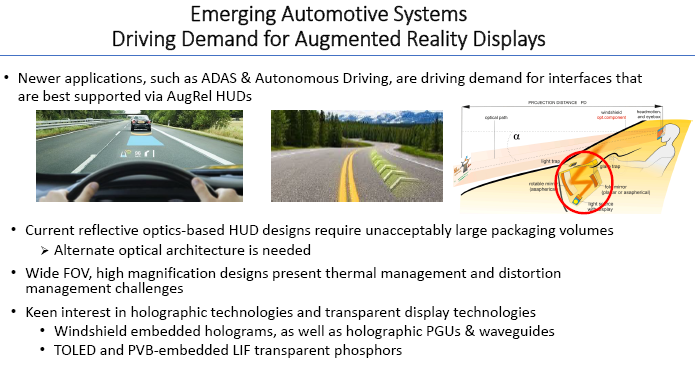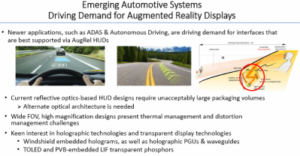Thomas Seder of GM (joined by James Carpenter also of GM for questions) talked about design in cars. He said that a group called EyesOn Design selected a GM Buick Avista for a design award, but newspaper readers also selected the car and the interior concept is really based around displays with unique and novel shapes and that is a challenge for the industry.
Curved and free form LCDs are interesting, although the uses are limited by the radius of curvature that is possible. Flexible OLEDs are fine, but image sticking is a real problem because autos often show high brightness fixed images for long periods, and that makes sticking worse. MicroLED is an interesting technology with “exceptional” power advantages over LCD.
Rectangular designs are simple to think about, but different shapes can be challenging and there is lots of work needed to understand how to present information. Autostereo displays may also have appeal although accomodation/convergence mismatch might be an issue. Multi layer displays (up to light field displays) are interesting but need careful design. Stereopsis is potentially a challenge, so GM thinks that displays may stay in 2D with monocular depth cues until light field displays are widely available.
Design cycles are long in automotive applications and 2020 models have already been designed and design teams are looking at 2021 models, now. Looking ahead, around 300ppi will be enough, but Rec 2020 colour will be desired – using QDs or other technology, such as quantum rods or colour conversion materials. The use of cadmium is a big issue and the auto industry needs to be able to guarantee a 10 year life (four years design plus six years model life) and the companies simply can’t take a risk on regulation deviations and exemptions.
New technologies that are interesting include Augmented Reality HUDs and GM is going after them strongly, but they are really difficult to develop if you want a wide field of view. There is a lot of interest in holographic and other transparent technologies for this application.

GM’s CT6 has a dual function device that can act as a mirror or as a display. There are challenges using displays because the focus of a mirror is at infintity but with a display, it’s close to the driver, which can cause trouble if they have presbyopia. There are similar challenges with side mirror replacements. Rear seat entertainment displays are interesting, but its hard to compete with carry-on devices, Seder said. That might mean using side windows that have a unique advantage compared to hand-helds.
Finally, in avionics, display engineering is all about controlling reflections and the same is true in automotive applications. Anti-microbial technology is an interesting for shared vehicles and anti-fingerprint coatings are important for the aesthetics for displays. Self-cleaning would be even better.
Analyst Comment
This was an interesting talk, especially the comments about image sticking in OLEDs and the use of cadmium in QDs. Arguably, the cadmium issue could be overcome by the new Nanosys Hyperion material, as it doesn’t rely on the ROHS exemption. I raised the issue of image burn/sticking with a number of OLED supporters at the event. They all dismissed it as “it’ll go away with engineering”, but GM’s comments suggest that a lot more needs to be done. If the TADF-based deep blue materials from Kyulux and Cynora are as good as they claim, that may help, but I’m still not convinced that OLEDs will overcome this quickly. (BR)

